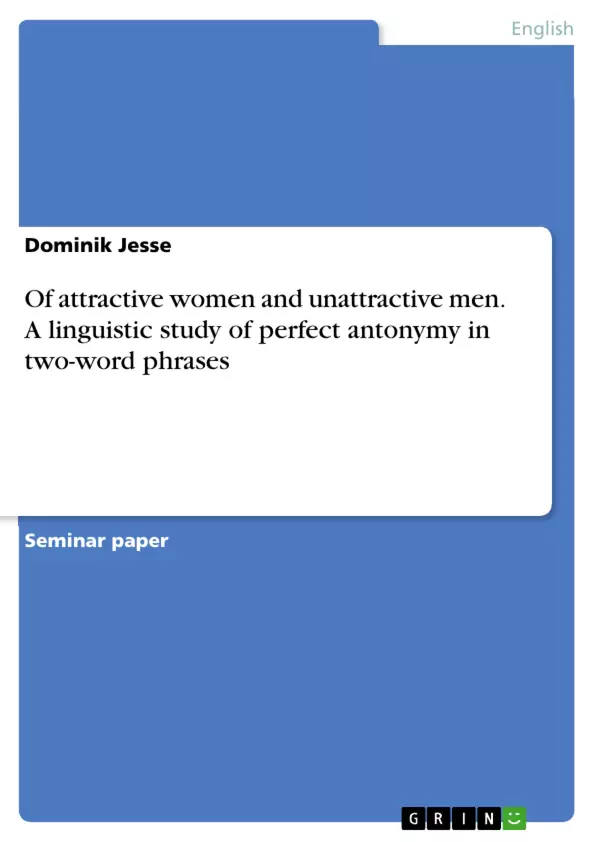In the English (and any other) language, antonymy belongs to the most interesting aspects which linguists may come across. Human beings think and speak in categories. Thus, they classify every word into groups by referring to one or several (suppositionally) equal characteristics of these words. In this respect, antonymy is simply a particular manner of categorization, but a rather keen one for its being based on the strong (albeit rarely logical ) differentiation from other words. Consequently, an antonym cannot occur on its own terms; it always needs another word to which it refers.
Much has been written about antonymy (Lyons 1977, Cruse 1992, Cruse 1995, Murphy 2006 et. al.). Yet, as far as is known, no scientific study has ever been conducted of a phenomenon that is to be called perfect antonymy and is related to the antonymy of entire phrases. This concept means that all single parts of a group of, at least, two words are turned into the opposite, as can bee seen in [1iiid] of the example [Example 1].
Table of Contents
- Introduction
- Literature
- Method
- Results
- Theoretical Discussion and Conclusion
- References
Objectives and Key Themes
This paper investigates the phenomenon of "perfect antonymy" in two-word phrases, specifically focusing on why it is rarely used in everyday communication. The study aims to determine the reasons behind this infrequent application and to explore the non-arbitrary nature of which word in a two-word phrase is changed to its opposite when antonymy is used.
- Definition and classification of antonyms
- Analysis of perfect antonymy in two-word phrases
- Examination of speaker choices in applying antonyms
- Exploration of the role of cultural meaning in antonymy
- Motivation for further research in this linguistic field
Chapter Summaries
Introduction: This chapter introduces the concept of perfect antonymy – a type of antonymy where all parts of a phrase are reversed. It highlights the lack of existing research on this phenomenon and states the paper's objective: to investigate why perfect antonymy is rarely used and which word speakers tend to reverse in a two-word phrase. The chapter lays the groundwork by briefly discussing the nature of antonymy and its significance in linguistics, posing the core research questions that guide the subsequent sections.
Literature: This chapter defines key terminology, primarily drawing upon Griffiths (2006), Murphy (2006), and Crystal (2014). It introduces and defines "perfect antonymy," differentiating it from common antonymy. The chapter categorizes antonyms into gradable, complementary, and relational antonyms, elaborating on their characteristics using examples and discussing the role of cultural meaning (connotation) versus linguistic meaning (denotation) in understanding antonyms. This provides the theoretical framework for analyzing the empirical data presented later in the paper.
Keywords
Perfect antonymy, two-word phrases, antonymy, linguistic categorization, cultural meaning, gradable antonyms, complementary antonyms, relational antonyms, empirical research, English language.
FAQ: A Comprehensive Language Preview on Perfect Antonymy in Two-Word Phrases
What is the main topic of this paper?
This paper investigates the phenomenon of "perfect antonymy" in two-word phrases, specifically focusing on why it is rarely used in everyday communication and exploring the factors influencing which word in a phrase is changed to its opposite.
What are the key objectives of the study?
The study aims to define and classify antonyms, analyze perfect antonymy in two-word phrases, examine speaker choices in applying antonyms, explore the role of cultural meaning in antonymy, and suggest areas for future research in this linguistic field.
What are the key themes explored in the paper?
Key themes include the definition and classification of antonyms (gradable, complementary, and relational), the analysis of perfect antonymy as a rare linguistic phenomenon, the investigation of speaker preferences in reversing words within two-word phrases, and the impact of cultural meaning on antonymic usage.
How is "perfect antonymy" defined in this paper?
Perfect antonymy is defined as a type of antonymy where all parts of a phrase are reversed. The paper contrasts this with more common forms of antonymy.
What types of antonyms are discussed?
The paper categorizes antonyms into gradable, complementary, and relational antonyms, providing examples and explanations of their characteristics.
What is the role of cultural meaning in the study?
The study explores how cultural meaning (connotation) and linguistic meaning (denotation) contribute to the understanding and application of antonyms, particularly in the context of perfect antonymy.
What is the structure of the paper?
The paper is structured into an introduction, a literature review, a methodology section (implied), a results section (implied), a theoretical discussion and conclusion, and a references section. The provided preview includes summaries of the introduction and literature review chapters.
What key words are associated with this research?
Key words include: Perfect antonymy, two-word phrases, antonymy, linguistic categorization, cultural meaning, gradable antonyms, complementary antonyms, relational antonyms, empirical research, English language.
What is the significance of the research?
The research contributes to the understanding of antonymy, specifically the less-studied phenomenon of perfect antonymy, shedding light on speaker choices and the interplay between linguistic and cultural factors in language use.
Where can I find more information on this topic?
The full paper would contain a detailed methodology, results, and references section which provide further detail and supporting evidence. The preview references Griffiths (2006), Murphy (2006), and Crystal (2014) as relevant sources.
- Citar trabajo
- Dominik Jesse (Autor), 2014, Of attractive women and unattractive men. A linguistic study of perfect antonymy in two-word phrases, Múnich, GRIN Verlag, https://www.grin.com/document/294745



